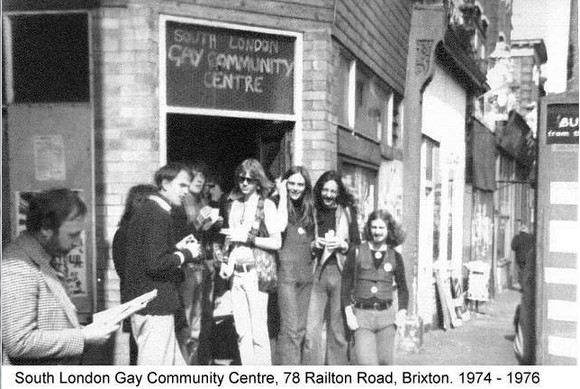
This fascinating story about Brixton’s legendary gay community of the 1970s was posted up on the urban75 bulletin boards, and thanks to the author Ian Townson, I’m now able to repost an illustrated version, giving a wonderful insight into a long lost part of Brixton life.
South London Gay Liberation by Ian Townson
The South London Gay Community Centre at 78 Railton Road, Brixton, was squatted by people who were determined to come out into the clear light of day with a public statement of gay identity.
It was the first of its kind and for two hectic years of ‘fits and starts’ the Centre established an undeniable and irreversible presence of gay people in the area.
The Centre opened in March 1974 and was evicted in April 1976.
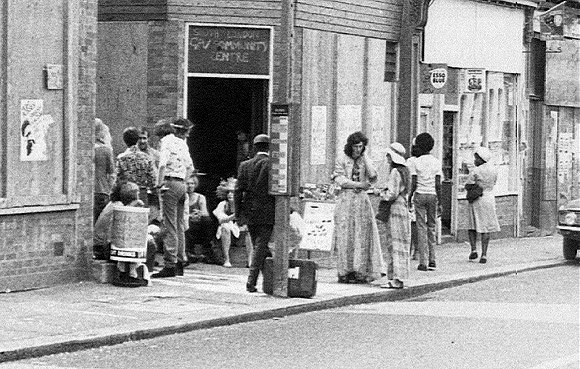
During the short period of its existence the Centre acted as a focal point bringing together gay people from many different backgrounds through social activities and political action.
The Centre also acted as a magnet attracting people into the area who squatted several back-to-back houses on Railton and Mayall Roads with a shared garden in between them.
This became the nucleus for further political activity after the closure of the Centre but equally it grew, over time, as an experiment in new communal living arrangements for gay people with varying levels of success.
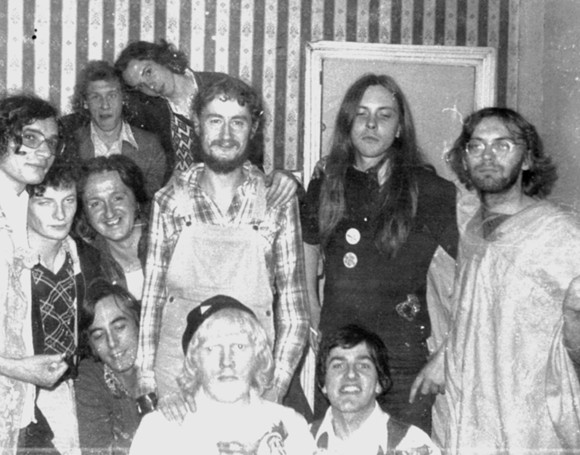
Kitchen of 152 Mayall Road. The two boys in the back row and the first on the left I think were visitors from
Germany. I don’t know their names. Second row L-R Paul ?, Malcolm Greatbanks, Edwin Henshaw, John Lloyd, Ian Townson (what was I wearing?), Stephen Gee peeping out from behind Edwin and Terry Stewart, Gerry Comey in the first row.
Gay people arrived at the squats for many different reasons. Some were desperately fleeing from oppressive situations in their lives. Others were glad to find the company of unashamedly out gay people rather than remain confused and isolated.
Some consciously saw this as an opportunity to attack ‘straight’ society through adopting an alternative lifestyle that challenged the prevailing norms of the patriarchal nuclear family and private property.
There were many visitors from overseas. Everything would be shared in common including sex partners and gender bending was encouraged to dissolve rigid categories of masculine men and feminine women. For others dressing in drag was a sheer pleasure and an opportunity for ingenious invention.
The ‘cultural desert’ in South London offered little social space in which to gather strength as ‘out’ gay people. The ‘straight’ gay scene was inhospitable, exploitative and a commercial rip off (it is now gay-owned, exploitative and a commercial rip off).
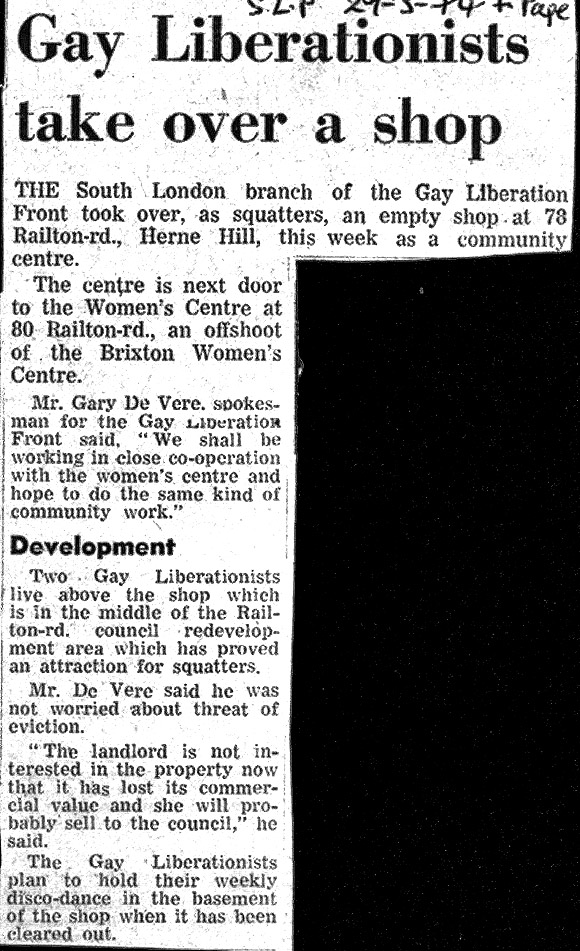
Brixton in the 1970s
Brixton was one of the most deprived inner city areas in London with high levels of unemployment and crime, a chronic shortage of housing stock with many dilapidated buildings left empty, large-scale environmental decay and blatant racism in an area with a large, young black population.
Into this cauldron of deprivation leapt a number of different groups in and around Railton Road to challenge the poverty and decay in people’s lives.
There were two women’s centres on Railton Road, an Anarchist News Service, Squatters Groups, a Claimants’ Union for those on welfare benefits, the Brixton Advice Centre, Icebreakers (a gay liberation counselling group), the Race Today Collective and a food cooperative in nearby Shakespeare Road and Atlantic Road.
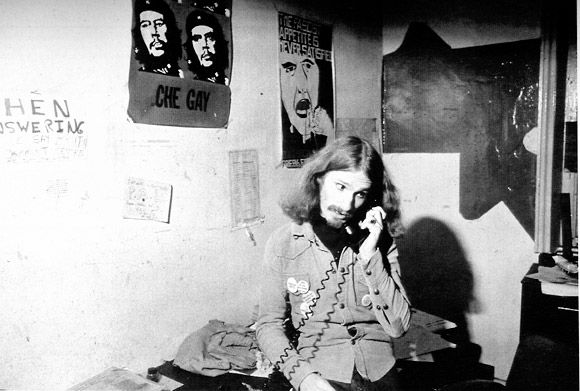
Alastair Kerr taking a call at the South London Gay Community Centre, 78 Railton Road, Brixton (mid 1970s)
The Gay Centre, as a self-determined group, also took its place among the other community based groups to challenge prejudice, discrimination, heterosexist attitudes and the complacency of officialdom.
There were many different activities at the Centre. A modern dance group was formed and run by Andreas Demetriou.
There was a wrestling group in the basement and, to counter the ‘macho’ posturing of the group, a sewing bee and knitting circle was formed in the upstairs front room run chiefly by Alistair Kerr and Malcolm Watson.
We participated in the local and general elections in 1974 with Malcolm Greatbanks, Alistair Kerr and Michael Mason as the candidates.
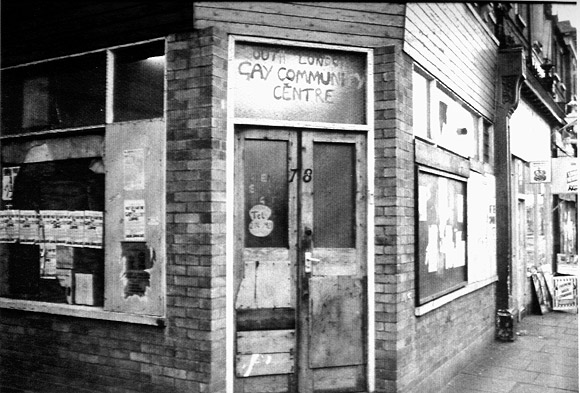
Being against Parliamentary Democracy as a meaningless sham it was pointed out that we were just doing this for the free publicity.
There were weekly discos in the basement, individual counsellors and regular meetings of the Centre ‘collective’ to determine which campaigns and social events we would support and be involved in.
Discos were also organised at Lambeth Town Hall and an open day was held for members of the public to come and meet us.
Besides all of this there was a regular duty rota so that all the people who visited the Centre would be greeted and made welcome. The 1976 Gay Pride event was also organised by Brixton Gays.
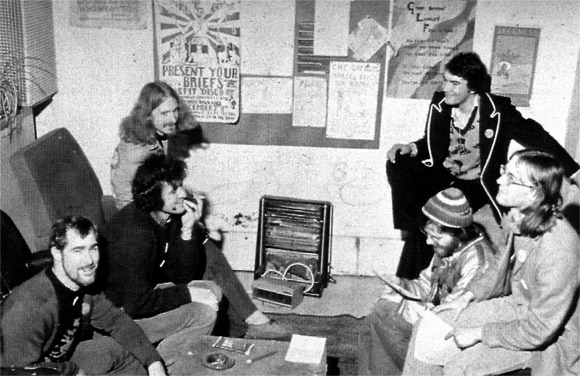
It is possible to convey some of the atmosphere of ‘communal’ living in photographs of the gay squats that sprang up around the Centre.
With a common garden between the houses the back doors were often left open so that people could come and go in and out of each others squats.
The kitchen more often than not became the hub of food, conversation and play. In the shared garden people would gather to dine Al Fresco or play music or even rehearse for various theatre productions. Even just camp it up for the hell of it.
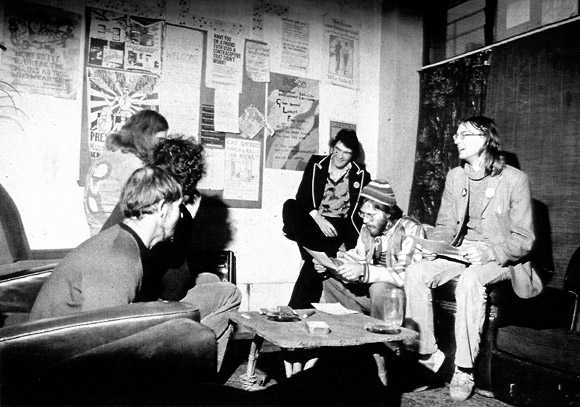
The gay squats eventually became part of the the Brixton Housing Co-op in the early 80s and were redeveloped into single person units.
While this made for more secure accommodation and the shared garden was kept in tact it led to a more ‘privatised’ existence and some of the original elan and spirit was lost as a result.
However the gay households are all still there with more or less permanent inhabitants.
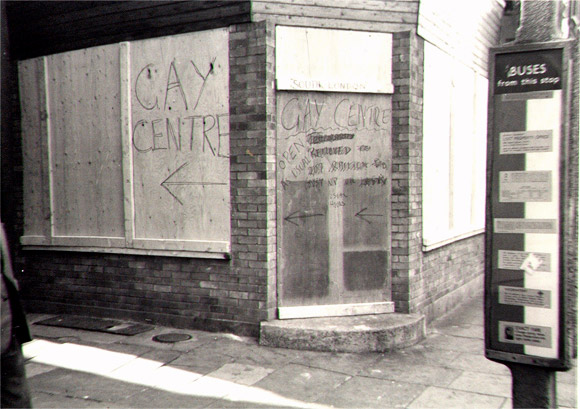
Brixton Riots
A special mention should be made of the Brixton riots of 1981 which happened chiefly as a result of the racism and heavy-handed harassment of black people by the police. The riots were centred around Railton Road and when Brixton was burning we showed our solidarity with the oppressed by joining them on the streets.
We even took tables and chairs out onto the street in front of the gay squats for a celebration party – some people in drag – getting a mixed reception from people on the steet. Some hostile, others indifferent, some amused.
Two of us were sent to prison for a couple of years for supplying petrol to the rioters.
South London Gay Liberation Theatre Group
The South London Gay Liberation Theatre Group, which later became the Brixton Faeries, produced several plays, sketches and street theatre performances. They were mostly unashamedly agit prop but later became more sophisticated with better characterisation and plotting. Beginning with a Gay Dragon paraded in a local street festival the group went on to perform sketches for local community groups.
The first play, ‘Mr Punch’s Nuclear Family’, was performed at the Centre and in a local school playground at a community event. The play attacked patriarchal values by showing the devastating effects on the wife and gay son of ‘rule by the father’ and the collusion of the male-dominated authorities in acquitting the father of murdering them (1975).
Next came ‘Out of it’ (1975/76) showing the relationship between patriarchal values, fascism and the extremes of christian morality and how they contributed to gay oppression. This was followed by ‘Minehead Revisited or The Warts that Dared to Speak their Name’.
A highly topical and controversial play at the time about the Jeremy Thorpe trial at the Old Bailey. As leader of the Liberal Party he had been accused of plotting to have a former male lover intimidated and even killed in order to keep him quiet about their affair (1977-80).
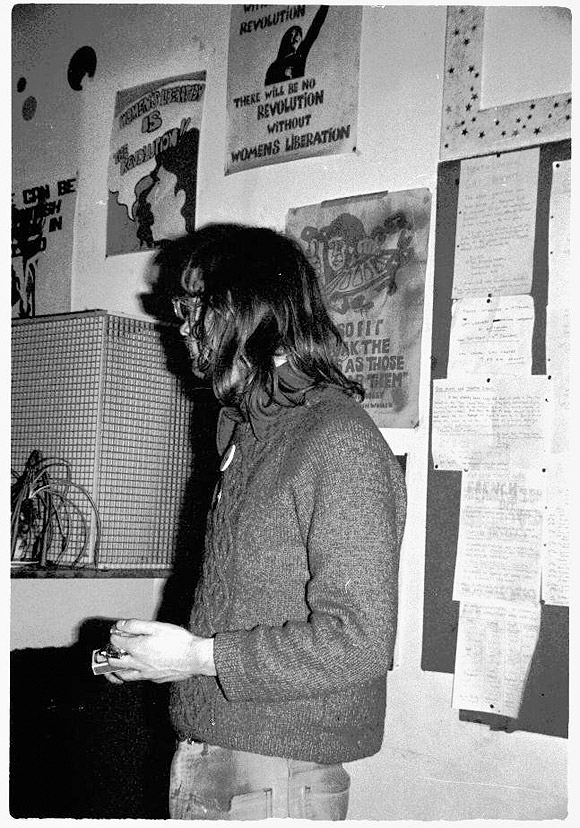
‘Tomorrow’s too Late’ was an anarchic blend of music, song and fantasy around gay activist groups and the banning of Gay News by WH Smith for carrying an advert about a paedophile group and later a poem by James Kirkup suggesting a homosexual relationship between Christ and a Roman soldier (1977-80). ‘Gents’ told the story of ‘cottaging’, that is, the reasons why men have sex with other men in public toilets.
The more respectable gays viewed cottaging as repulsive and giving ordinary, decent gay people a bad name. The police frequently arrested and charged men with ‘gross indecency’ often ruining their lives in terms of losing jobs and destroying relationships.
Brixton Faeries decided to expose the oppressive nature of police entrapment and to present cottaging in positive terms as an ideal fantasy even going so far as to suggest the local council attempting to stump up funding to ‘improve facilities’ (1978-80).
We also did Joint productions with various other groups such as Gay Sweatshop in ‘Radio Gay’ at the Oval House Community Centre.
Most of the productions were at fringe theatres or community centres and one performance of ‘Out of it’ was in front of the Young Communist League who were shocked to see two men kissing on stage.
Homophobic pubs
We picketed several pubs that we had been thrown out of in and around Railton Road for kissing and cuddling two of which, The George Hotel and The Windsor Castle, were burned to the ground during the Brixton riots in 1981. The George Hotel had previously been prosecuted under the Race Relations Act for barring black people.
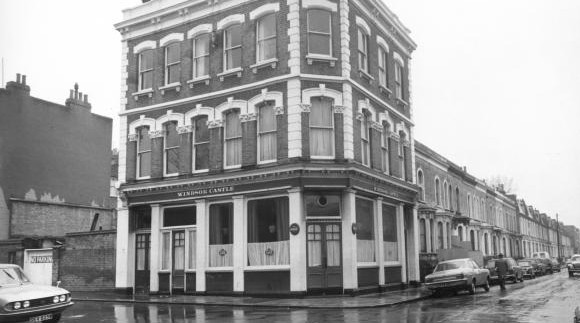
The Windsor Castle on Mayall Rd.
Queens in Furs refused to pay local rates because none of the rates were used to provide amenities for gay people. The fur coat wearing was another way of gay men challenging rigid masculine identities.
Those who refused to pay rates were summoned to Camberwell Magistrates’ Court where the presiding judge had difficulty in persuading the plaintiffs that they should ‘know their place’ and behave accordingly. Gary de Vere was thrown out for polemicsing out loud and our arguments were rejected. We lost the case as we thought we would but publicity was gained as a result.
We insisted that the Centre should be publicly funded as a right and applied to Lambeth Council for a grant rather than scraping pittance money out of our pockets for general upkeep and paying the rates. The grant was refused.
It was argued that the Centre should be privately funded despite the council granting money to other groups in the area.
Eviction
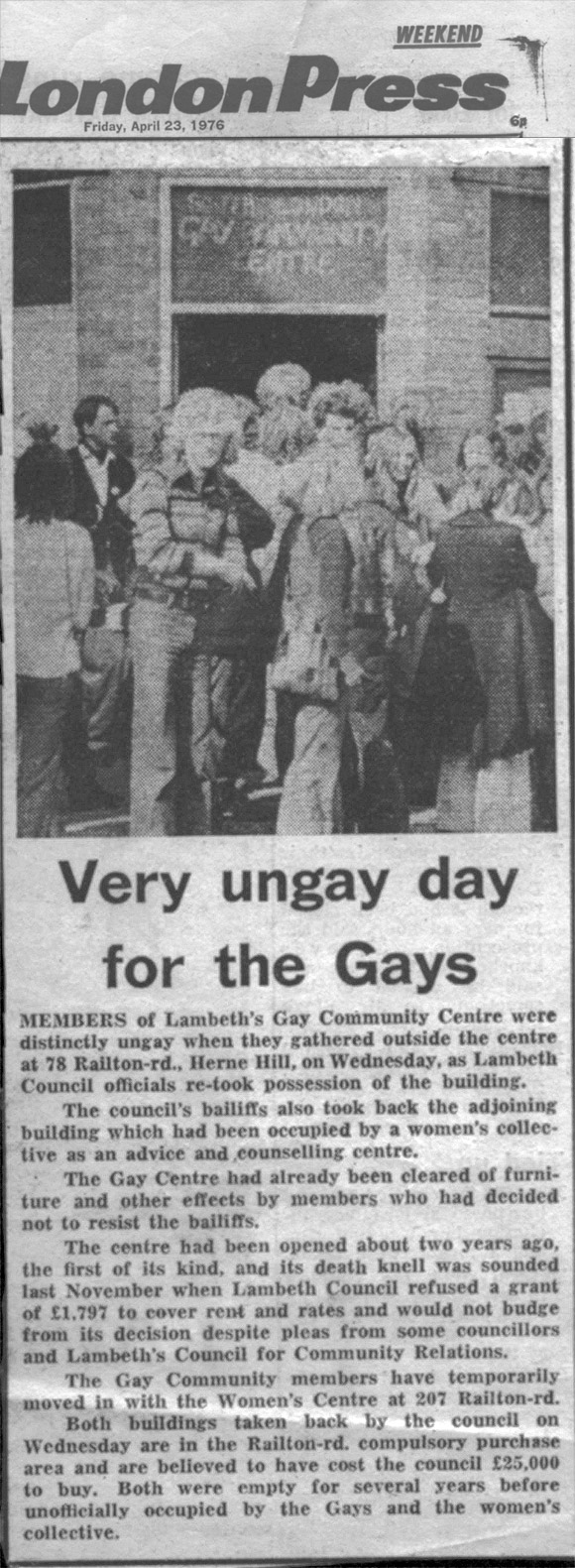
Bailiffs and police evicting the South London Gay Community Centre at 78 Railton Road, Brixton (April 1976).
The end of the centre
Many people who used the Centre were unemployed and could not afford to fund it. Infighting between different factions and lack of funding contributed to the demise of the Centre.
However the final blow came when the Centre was evicted by police and bailiffs so that the private owners could take vacant possession of the property and sell it to Lambeth Council for redevelopment.
Thus bringing to an end the first public and visible institution with a clear gay identity. With this closure the focus for political and social activity shifted from the Centre to the gay squats.
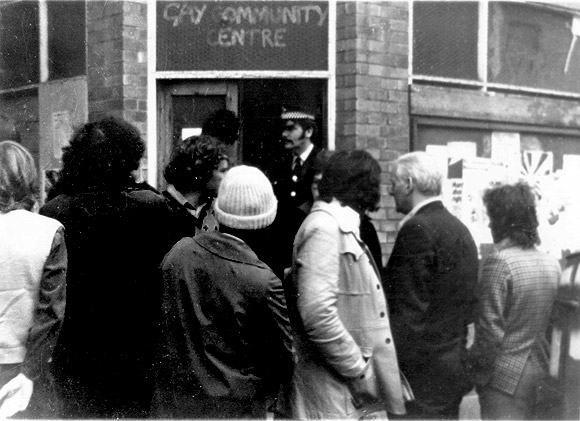
Police, workmen and bailiffs arrive to evict the South London Gay Community Centre with some gay people present to object. Jamie Hall, Colm clifford and Alistair Kerr (I think) on the left.
The National Gay News Defence Committee was originally based at 146 Mayall Road and then moved to 157 Railton Road with Stephen Gee as one of the main organisers. The group was set up when Mary Whitehouse, a right-wing moral crusader, prosecuted Gay News on a charge of blasphemous libel for carrying the already mentioned poem by James Kirkup.
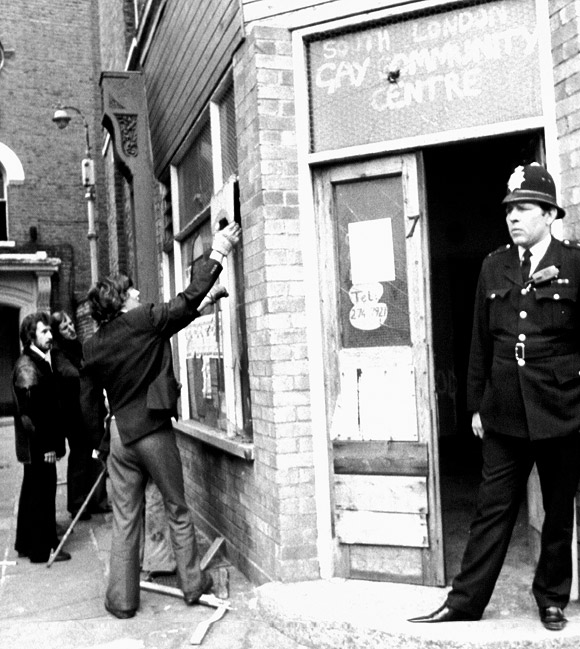
Workmen preparing to board up the Gay Centre after the eviction with a gormless looking copper standing guard. We moved back in once it had been sealed up. April 1976.
This happened at a time when there was also much police activity against gay people in different parts of the country on cottaging charges and the wrongful assumption that we were paedophiles.
With the successful prosecution of Gay News the NGNDC became the Gay Activists’ Alliance and continued with both national and international campaigns with many locally active groups.
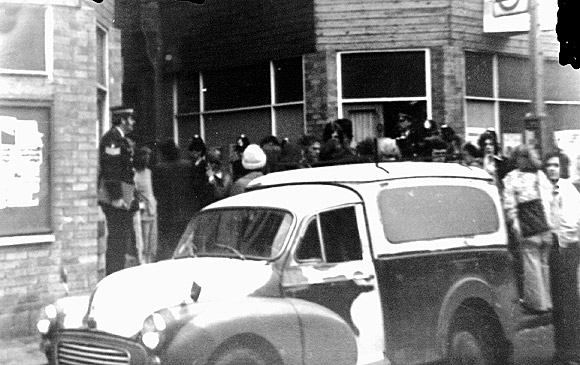
Centre being evicted
National Front
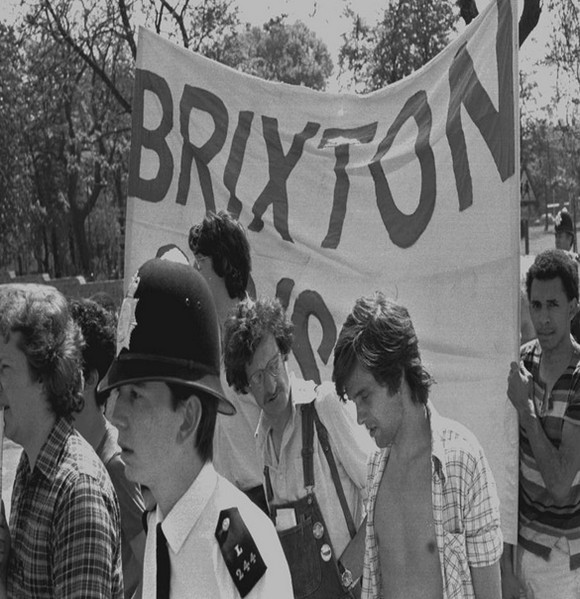
Also the fascist National Front was particularly active at this time; mostly against immigrants, black people and left-wing organisations but also several gay establishments had been attacked by them including the Vauxhall Tavern in South London.
In 1978 a massive Anti-Nazi League march came along Railton Road for a Rock Against Racism festival in Brockwell Park. We fully supported the demonstration and the marchers passed under a banner we had slung high across Railton Road saying: Brixton Gays Welcome Anti-Fascists.
Also there was Anita Bryant, the Florida Orange lady, who campaigned in the United States against gays. Her famous phrase was: ‘God made Adam and Eve not Adam and Steve’ and she became even more famous when an irate gay activist shoved a cream pie in her face in full view of television cameras.
A special mention should be made of the Union Place Community Resource Centre in Brixton which encouraged us to go along and make posters, diaries, badges, calendars and banners for our campaigns. Ian Townson and Colm Clifford from the gay community became employees and Colm initiated ‘Homosexual Posters’ from there producing pictorial biographies of gay people and even gay Christmas cards.
More info
Brixton’s radical past: when lesbians were barred from the Brady’s/Railway Hotel pub in the 1970s (Oct 2020 update)
More reading:
There’s a long running and fascinating thread our bulletin board thread – The Brixton Fairies: 1970s gay squat. Contributors include many former activists and residents.
There’s another detailed personal account from Felix Alvarez in the thread as well as an article from 1978 by Brixton Faerie, Terry Stewart and a contribution from the gay rights campaigner and BBC6 DJ, Tom Robinson.
If you have your own memories of this gay community – or any photos you’d like to share – please post them on the thread, add them here or send us a message.
(*Thanks again to Ian Townson for this article).

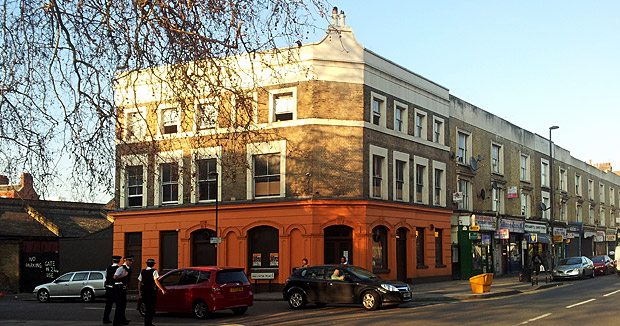
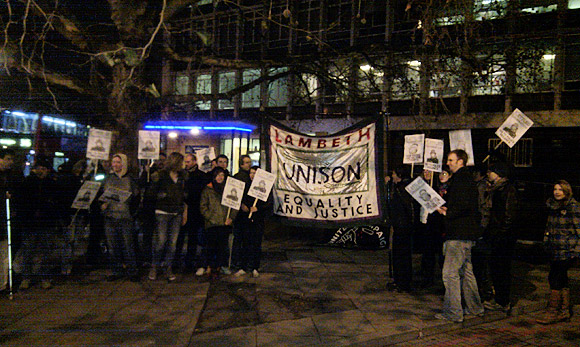
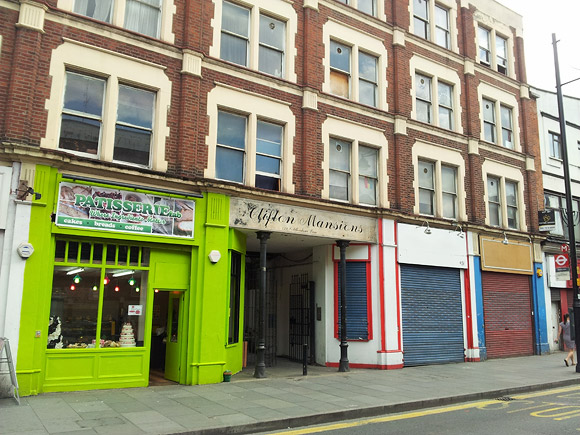
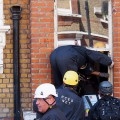
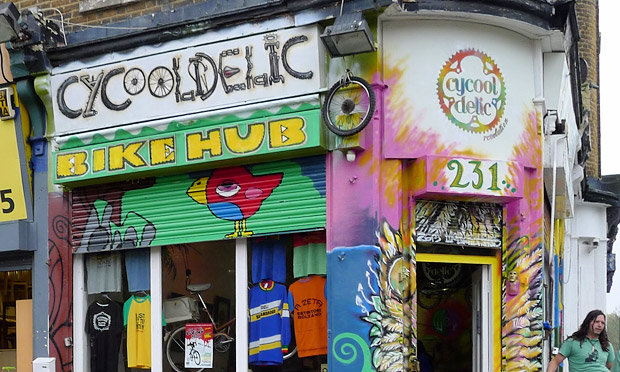
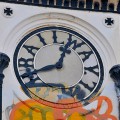
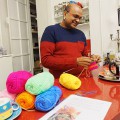
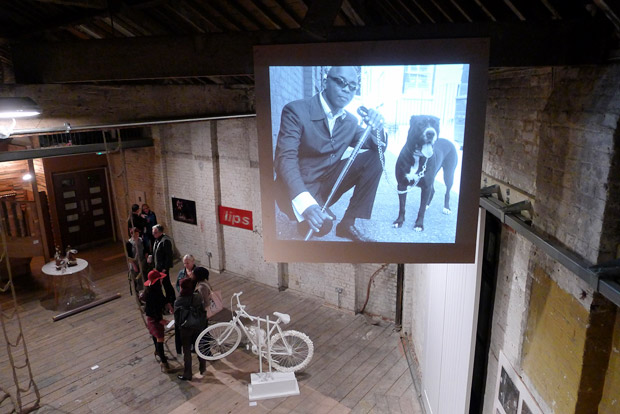
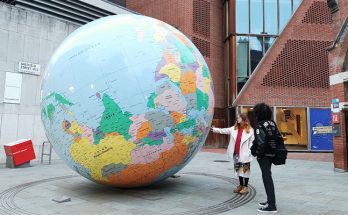
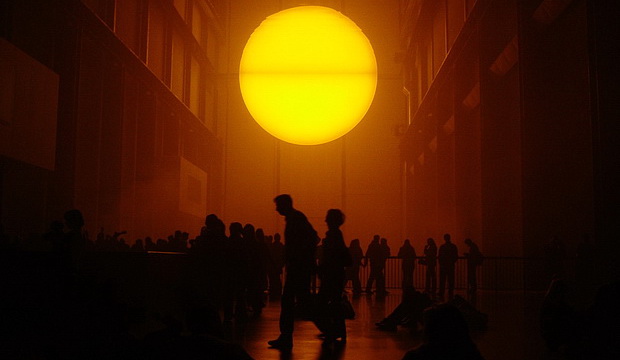
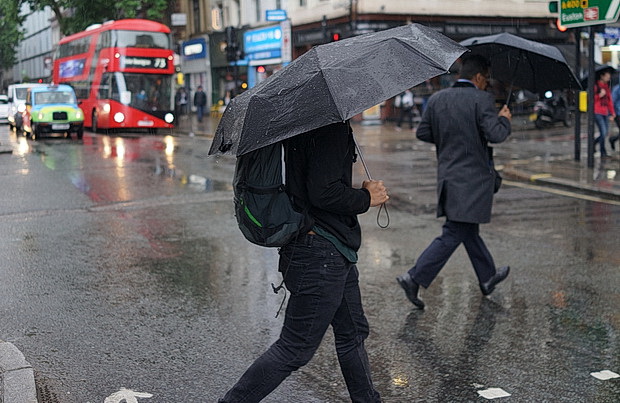
Thanks Mike. Given all the photos and text I threw in your direction you have done a fantastic job. Well done. I’m sure it will raise a lot of interest and contribute to a history of Brixton in revealing what would otherwise have been a ‘hidden’ aspect if it had not been for this site and our efforts.
Unfortunately the text I supplied is a bit threadbare. It was designed to fit in with the photographs and illustrations. Hopefully we will get people contributing to fill in the gaps and correct any errors on my part.
One point about attribution. All the material I sent to you was originally in my possession. However I deposited it at the Hall-Carpenter Archive based at the LSE. I thought I would give them a plug.
I realise you have been very busy and it has taken you quite some time to put this together but one again thanks for your Herculean efforts.
Ian Townson
Hello I am a nephew of Malcolm Greatbanks (RIP) and was blown away by the photo of my uncle in this post. I was born in 1972 and this era of my uncle’s life isn’t well documented to me, although we used to talk regularly from the late 80’s up to his passing. His Dad (my Grandad) basically disowned Malcolm for a considerable time, finally reconciling fully at his Mum and Dad’s Ruby Wedding anniversary c1986. I’d love to know if you have any more photos or stories regarding my uncle. It was very interesting to read of his involvement in the ’74 elections and of the group as a whole. Thanks for this insight. I realise I’m posting on an old topic, but thought it was worth a try!
Hi Andy. I found this blog yesterday while trying to get up to date information on your uncle Malcolm. I was saddened to read your post that he has passed away – please accept my (very belated) condolences. Malcolm and I were friends at Queens’ College, Cambridge, where we shared rooms in our 2nd year – 1965/66. Around that time, me and my girlfriend visited him at his family home in Manchester. We were made welcome by his mum and dad, and I think we met his sister – your mum? The last time I saw him was in London in 1968 or 69, but we lost touch after I emigrated to Canada in 1969. I was glad to see his familiar happy, smiling face in the photo above at Mayall Rd. Your uncle Malcolm was very smart and a good, kind man.
Hi Andy,
I haven’t been on this thread for a very long time and I have only just noticed your post.
It’s Ian Townson here and I have another photo of Malcolm, your uncle, but I am not sure how to send it to this thread. I will speak to Mike who looks after it to see what can be done.
Alternatively you could email me and by return email I could send you the photograph. I expect Philip Wormwell might want a copy too.
Best wishes.
Hello Andy, I knew Malcolm very well. I was the election agent in 74.If you see this after all this time respond and we can talk. xxx Susan Winter (then Wakeling),
Hi Andy. I guess you’re May and Bill’s son. I knew Malcolm very well as our families were friends (your grandfather and my father were at primary school together) and I’d like to get in touch. I have only one photograph of Malcolm but many memories of him and the family. I last saw him in 1990 as I was leaving for Australia after which we lost touch. I was very sorry to learn of his passing only a few days ago when I saw your request. I hope you pick this up after all this time!
Given all the photos and text I threw in your direction, Mike, you have done a fantastic job. Well done. I’m sure it will raise a lot of interest and contribute to a history of Brixton in revealing what would otherwise have been a ‘hidden’ aspect if it had not been for this site and our efforts.
Unfortunately the text I supplied is a bit threadbare. It was designed to fit in with the photographs and illustrations. Hopefully we will get people contributing to fill in the gaps and correct any errors on my part.
One point about attribution. All the material I sent to you was originally in my possession. However I deposited it at the Hall-Carpenter Archive based at the LSE. I thought I would give them a plug.
I realise you have been very busy and it has taken you quite some time to put this together but one again thanks for your Herculean efforts.
Ian Townson
Thhat was a very well put together reminder of yesterdays Gay Community. Here is a piece I wrote which is an overview of what was going down for us in Brixton at the time.
Fighting on all fronts 1978
by Brixton Faerie, Terry Stewart
1978 seems like another lifetime, when one looks at the massive changes in both Gay lifestyles and social attitudes. I do recall the gay movement was fighting on about four or five different front around various issue such as, the Gay news appeal at the law courts, which was lost. WH Smiths continued its shelf ban of Gay News. Nazi’s were on the march of hate, and the attempt by the far right to link homosexuality and pedophilia, was in full swing. Finally Captain Morgan’s Homophobic advertising was getting a good battering from queens “You don’t say hello sailor to a Captain Morgan’s drinker”. On all fronts queens were fighting back.
Great gains had been made in America with the election of the first Gay Mayor of San Francisco Harvey Milk. Sadly some deranged religious nut murdered Harvey. The down side was, Anita Bryant a B movie starlet, whose career went nowhere, accept on a homophobic rampage. She wasn’t very good at selling Florida Orange juice either. She lost that job thanks to the Gay lobby in America.
Disco was still all the rage and it seemed like we were never going to stop dancing. Gay Sweatshop Theatre Company was pumping out great shows, as were Blue Lips. Hot Peaches the American theatre group had made a tour of England and Germany and as a result we were all inspired, by their production The Divas of Sheridan Square. So much so that Brixton Fairies theatre company was formed. Not to forget Eric Preslands productions on Hampstead Heath. Can you imagine all that Gay theatre? The women’s group Ova was beginning to make a name on the women’s circuit. We were Cultured, Radical and ready to take on the World. So much so that the International Gay and Lesbian Association was formed.
Ron Peck the Film Director was just putting together the final script for the film Night Hawks, which depicted the dilemma of a Gay schoolteacher being in the closet. Ron went on to direct the sequel Strip Jack Naked, which I would recommend every young Gay and Lesbian see to get a flavour of the period, nothing to do with the fact that I have a brief cameo role in the film, which lasts all of fifteen seconds.
A good night at the cinema was to see the latest John Waters cult movies staring the diva of all time Divine, of Hair Spray fame, god rest her little socks.
Poor Julian Hows was having a hard time at work. London Transport had introduced new uniform policy, were female staff could wear trousers if they wish, so Julian decided it should work both ways and arrived on the platform at Earls Court station in a little grey two piece LT skirt and top. Management were outraged.
We didn’t have Employment Rights, no we had to just go in and brazen it out and hope for the best. British Homophobic Stores didn’t particularly like us then, and we had to make a few visits to their shops and let them know we were not shopping.
Schoolteachers were getting it in the neck big time and the Gay Teachers Group had a very robust campaign around the issue of being gay and out in the classroom. It was a few years later that the whole issue of Section 28 came along and undone any gains made.
Cottaging was another major issue at the time. People did cottage and large numbers of those who did were closeted or gay men who saw no dilemma in such Social, Public and Municipal activities. There were of course the Moral Mary’s who frowned upon such behaviour and would accuse those who did, of “dragging our good name in the mud”. Begs the question, what good name?
The Police were raiding the Gay scene on a phenomenal scale, along with a general clampdown on Gays in Bradford, Leeds, Manchester and London to name but a few. This was very much lead by the Commissioner of the Manchester Police Mr. Anderton, who said that God had spoken to him with regards to Homosexuality.
Finally Reverend Ian Paisley had established the “Save Ulster from Sodomy” campaign the previous year, and it was well and truly producing the bigotry and hatred that he wanted to unleash on the Gay community in the North of Ireland.
The morning of Gay Pride was different in 1978. We would not be marching up Oxford Street freaking out the Shoppers and Tourist. No this year we would march right through a residential area were real people lived, and reclaim the streets of Earls Court which was very much the Gay Mecca of the Time.
All that year the queens at the various pubs had been having a very tough time with the local police. Night after night there had been arrests around the Colherne Pub. It wasn’t quite Stonewall, but Queens were fighting back and not being bullied by the Lille. This march would be in solidarity with those Out on the Gay Scene and would take us right to the heart of “The Gay Community”.
We were up early that morning and some queens were having a Champers breakfast before taking on London. The Gay Dragon, which would be the centerpiece of the march, was having the final touches put to it, and there was a practice march around the garden to make sure everyone had the general idea of how to dragon dance and breath at the same time. We had the usual Black Steel Band to lead us through the streets of London, as was the case for a number of years.
I can’t understand where this argument of Black people being more Homophobic than white people came from. You should try being an Irish Catholic gay man. This same backward argument would be used later to move the Pride festival out of Brockwell Park. This certainly wasn’t our experience having lived on the frontline in Brixton for several years in an openly Gay Commune.
Pearl a lovely big Jamaican women had her Gay Shebeen on the frontline were Black and White gay men would dance until the wee small hours. It wasn’t quite Queer Nation, but we did enjoy ourselves, in an environment that was free from the usual racism that was pretty much run of the mill prejudices encountered by black people on the gay scene at the time.
Back to the Gay Pride March. The word Festival would come later when the Gay Pink Pounders would attempt to de-politicize the annual event. “Waving banners up and down Oxford Street screaming your tits off is all very well, but we want to be respectable” I heard one queen arguing. We all headed over to West London to begin our Annual Ritual of letting Joe Public know, that we were Out and Proud.
Everything was going well until we arrived outside the Colherne pub, where a bunch of tacky queens came out and decided to bottle the march, not a very good move. Handbags at dawn. If we were not going to be bottled by straights, we certainly were not going to be bottled by our own. Some queens rushed the pub lead by His Eminence Julian and put down the revolt in a way that only queens know how. Julian came out of the pub like the Victor over the Vanquished with his booty, a great big handsome Leather queen and some others who joined the march. It all ended very positive with the regulars all coming out and cheering us on.
The march was very lively and upbeat. We didn’t have 95,000 people, but the residents of West London knew we had arrived. The last big march we had was in February which we managed to mobilize thousands on the issue of “Stop the Backlash” which was during a period of general Homophobia on a wide scale with a lose coalition of the religious right, various sections of the establishment and far right political organizations.
The Gay Pride Ball that evening was held at Chelsea Town Hall and was a tremendous success until some straight male bouncer decided to chat up some of the lesbians. All hell broke out. We had just finished our production called “Swan Vista on Rice” which was a ballet on roller skates and a piss take of the John Curry on Ice show, which every family were flocking to see.
By closing time the police had arrived with dogs and began to clear the hall. We all stood outside, began to sing, blow them kisses and make offers of a good night out, as they retreated with the little dignity they had left, back into their little powder blue panda cars.
The various Gay Centres around London were being attacked night after night. Even known Gay households were firebombed and windows caved in. It was a question of having to get out there and fight for our very survival.
There is nothing more terrifying to a Homophobe than a queen dragged up to the nines wielding a club and screaming obscenities. It often worked and the only damage was a few broken cuticles and nothing a good hairbrush wouldn’t sort out.
The Economy was in a mess the IMF and World Bank had already threatened to bankrupt the country, even though we were pumping out that black gold in the North Sea. This period also saw a fragmentation of the left in general and the gay and lesbian movement in particular.
Labour Government in power, broken promises and a shift to the right by the same Government. Does this sound familiar?
At a more general level we had seen Workers and Trade Unions begin to take a hammering as the powers that be, began to clampdown on the movement, and remove any gains made during the previous period.
The reason I raise these issues is to illustrate how fragile our rights are and how the economic impact on the broader community affects us.
It was only a very short time before Disco would become House, GLF would become Stonewall and Revolution would become Reform. The economy was in a mess and so was our makeup and we were going to need more than a mascara brush to sort out the dilemmas within the Gay Movement. The rest is another story for another day.
Some of you will have different memories. Nights out at the Vauxhall Tavern, Bangs Disco, or a romp at the Gigolo and a dance at the Sombrero. Even pubs such as the Salisbury, The Golden lion or the A & B or the Embassy club will spring to mind. The Gateways was at its peak for women. I think the Catacombs may have already closed down.
Twenty-five years later, seeing young Gay and Lesbians experiencing a better life than the nightmare we were up against, is a joy to be celebrated.
To see old friends is always a great pleasure, because from 1982 onwards HIV and AIDS devastated our community. We lost almost a whole generation of friends and people who were very valuable to us all.
It was a very tough time but thanks to the likes of His Eminence Julian and others who have stayed around and did the most tremendous work around HIV and AIDS. You are probably asking yourself is this an article on Pride History or Julian Hows, and my response is, you can’t separate them.
Individuals don’t make history, but history does make individuals and Julian is one of them. It is about the early queens who survived and stayed to fight. The unsung heroes that don’t get mentioned.
That is Pride worth celebrating, worth fighting for, worth remembering and worth gold dust nearly forty years later. I wouldn’t change it for the world you hear me say. I would’nt.
I can’t for the life of me remember what happened to the Gay Dragon. Someone put that Gloria Gaynor track on again.
Thanks for that really good article. Here is an overview which I did a number of years ago, might still be on the thread somewhere.
Fighting on all fronts 1978
by Brixton Faerie, Terry Stewart
1978 seems like another lifetime, when one looks at the massive changes in both Gay lifestyles and social attitudes. I do recall the gay movement was fighting on about four or five different front around various issue such as, the Gay news appeal at the law courts, which was lost. WH Smiths continued its shelf ban of Gay News. Nazi’s were on the march of hate, and the attempt by the far right to link homosexuality and pedophilia, was in full swing. Finally Captain Morgan’s Homophobic advertising was getting a good battering from queens “You don’t say hello sailor to a Captain Morgan’s drinker”. On all fronts queens were fighting back.
Great gains had been made in America with the election of the first Gay Mayor of San Francisco Harvey Milk. Sadly some deranged religious nut murdered Harvey. The down side was, Anita Bryant a B movie starlet, whose career went nowhere, accept on a homophobic rampage. She wasn’t very good at selling Florida Orange juice either. She lost that job thanks to the Gay lobby in America.
Disco was still all the rage and it seemed like we were never going to stop dancing. Gay Sweatshop Theatre Company was pumping out great shows, as were Blue Lips. Hot Peaches the American theatre group had made a tour of England and Germany and as a result we were all inspired, by their production The Divas of Sheridan Square. So much so that Brixton Fairies theatre company was formed. Not to forget Eric Preslands productions on Hampstead Heath. Can you imagine all that Gay theatre? The women’s group Ova was beginning to make a name on the women’s circuit. We were Cultured, Radical and ready to take on the World. So much so that the International Gay and Lesbian Association was formed.
Ron Peck the Film Director was just putting together the final script for the film Night Hawks, which depicted the dilemma of a Gay schoolteacher being in the closet. Ron went on to direct the sequel Strip Jack Naked, which I would recommend every young Gay and Lesbian see to get a flavour of the period, nothing to do with the fact that I have a brief cameo role in the film, which lasts all of fifteen seconds.
A good night at the cinema was to see the latest John Waters cult movies staring the diva of all time Divine, of Hair Spray fame, god rest her little socks.
Poor Julian Hows was having a hard time at work. London Transport had introduced new uniform policy, were female staff could wear trousers if they wish, so Julian decided it should work both ways and arrived on the platform at Earls Court station in a little grey two piece LT skirt and top. Management were outraged.
We didn’t have Employment Rights, no we had to just go in and brazen it out and hope for the best. British Homophobic Stores didn’t particularly like us then, and we had to make a few visits to their shops and let them know we were not shopping.
Schoolteachers were getting it in the neck big time and the Gay Teachers Group had a very robust campaign around the issue of being gay and out in the classroom. It was a few years later that the whole issue of Section 28 came along and undone any gains made.
Cottaging was another major issue at the time. People did cottage and large numbers of those who did were closeted or gay men who saw no dilemma in such Social, Public and Municipal activities. There were of course the Moral Mary’s who frowned upon such behaviour and would accuse those who did, of “dragging our good name in the mud”. Begs the question, what good name?
The Police were raiding the Gay scene on a phenomenal scale, along with a general clampdown on Gays in Bradford, Leeds, Manchester and London to name but a few. This was very much lead by the Commissioner of the Manchester Police Mr. Anderton, who said that God had spoken to him with regards to Homosexuality.
Finally Reverend Ian Paisley had established the “Save Ulster from Sodomy” campaign the previous year, and it was well and truly producing the bigotry and hatred that he wanted to unleash on the Gay community in the North of Ireland.
The morning of Gay Pride was different in 1978. We would not be marching up Oxford Street freaking out the Shoppers and Tourist. No this year we would march right through a residential area were real people lived, and reclaim the streets of Earls Court which was very much the Gay Mecca of the Time.
All that year the queens at the various pubs had been having a very tough time with the local police. Night after night there had been arrests around the Colherne Pub. It wasn’t quite Stonewall, but Queens were fighting back and not being bullied by the Lille. This march would be in solidarity with those Out on the Gay Scene and would take us right to the heart of “The Gay Community”.
We were up early that morning and some queens were having a Champers breakfast before taking on London. The Gay Dragon, which would be the centerpiece of the march, was having the final touches put to it, and there was a practice march around the garden to make sure everyone had the general idea of how to dragon dance and breath at the same time. We had the usual Black Steel Band to lead us through the streets of London, as was the case for a number of years.
I can’t understand where this argument of Black people being more Homophobic than white people came from. You should try being an Irish Catholic gay man. This same backward argument would be used later to move the Pride festival out of Brockwell Park. This certainly wasn’t our experience having lived on the frontline in Brixton for several years in an openly Gay Commune.
Pearl a lovely big Jamaican women had her Gay Shebeen on the frontline were Black and White gay men would dance until the wee small hours. It wasn’t quite Queer Nation, but we did enjoy ourselves, in an environment that was free from the usual racism that was pretty much run of the mill prejudices encountered by black people on the gay scene at the time.
Back to the Gay Pride March. The word Festival would come later when the Gay Pink Pounders would attempt to de-politicize the annual event. “Waving banners up and down Oxford Street screaming your tits off is all very well, but we want to be respectable” I heard one queen arguing. We all headed over to West London to begin our Annual Ritual of letting Joe Public know, that we were Out and Proud.
Everything was going well until we arrived outside the Colherne pub, where a bunch of tacky queens came out and decided to bottle the march, not a very good move. Handbags at dawn. If we were not going to be bottled by straights, we certainly were not going to be bottled by our own. Some queens rushed the pub lead by His Eminence Julian and put down the revolt in a way that only queens know how. Julian came out of the pub like the Victor over the Vanquished with his booty, a great big handsome Leather queen and some others who joined the march. It all ended very positive with the regulars all coming out and cheering us on.
The march was very lively and upbeat. We didn’t have 95,000 people, but the residents of West London knew we had arrived. The last big march we had was in February which we managed to mobilize thousands on the issue of “Stop the Backlash” which was during a period of general Homophobia on a wide scale with a lose coalition of the religious right, various sections of the establishment and far right political organizations.
The Gay Pride Ball that evening was held at Chelsea Town Hall and was a tremendous success until some straight male bouncer decided to chat up some of the lesbians. All hell broke out. We had just finished our production called “Swan Vista on Rice” which was a ballet on roller skates and a piss take of the John Curry on Ice show, which every family were flocking to see.
By closing time the police had arrived with dogs and began to clear the hall. We all stood outside, began to sing, blow them kisses and make offers of a good night out, as they retreated with the little dignity they had left, back into their little powder blue panda cars.
The various Gay Centres around London were being attacked night after night. Even known Gay households were firebombed and windows caved in. It was a question of having to get out there and fight for our very survival.
There is nothing more terrifying to a Homophobe than a queen dragged up to the nines wielding a club and screaming obscenities. It often worked and the only damage was a few broken cuticles and nothing a good hairbrush wouldn’t sort out.
The Economy was in a mess the IMF and World Bank had already threatened to bankrupt the country, even though we were pumping out that black gold in the North Sea. This period also saw a fragmentation of the left in general and the gay and lesbian movement in particular.
Labour Government in power, broken promises and a shift to the right by the same Government. Does this sound familiar?
At a more general level we had seen Workers and Trade Unions begin to take a hammering as the powers that be, began to clampdown on the movement, and remove any gains made during the previous period.
The reason I raise these issues is to illustrate how fragile our rights are and how the economic impact on the broader community affects us.
It was only a very short time before Disco would become House, GLF would become Stonewall and Revolution would become Reform. The economy was in a mess and so was our makeup and we were going to need more than a mascara brush to sort out the dilemmas within the Gay Movement. The rest is another story for another day.
Some of you will have different memories. Nights out at the Vauxhall Tavern, Bangs Disco, or a romp at the Gigolo and a dance at the Sombrero. Even pubs such as the Salisbury, The Golden lion or the A & B or the Embassy club will spring to mind. The Gateways was at its peak for women. I think the Catacombs may have already closed down.
Twenty-five years later, seeing young Gay and Lesbians experiencing a better life than the nightmare we were up against, is a joy to be celebrated.
To see old friends is always a great pleasure, because from 1982 onwards HIV and AIDS devastated our community. We lost almost a whole generation of friends and people who were very valuable to us all.
It was a very tough time but thanks to the likes of His Eminence Julian and others who have stayed around and did the most tremendous work around HIV and AIDS. You are probably asking yourself is this an article on Pride History or Julian Hows, and my response is, you can’t separate them.
Individuals don’t make history, but history does make individuals and Julian is one of them. It is about the early queens who survived and stayed to fight. The unsung heroes that don’t get mentioned.
That is Pride worth celebrating, worth fighting for, worth remembering and worth gold dust nearly forty years later. I wouldn’t change it for the world you hear me say. I would’nt.
I can’t for the life of me remember what happened to the Gay Dragon. Someone put that Gloria Gaynor track on again.
Great stuff Ian , Mike & Terry – Thanks
Hello
Well done to the editor for the great article first of all
We are a couple of gay film-makers who live in the Brixton area and we would like to do a documentary about this amazing story!
We have friends who currently live in the community who have given us their account about the community, but we found this forum a great resource
At the moment we are writing a proposal in order to raise funding and we would like to include already a list of possible interviewees, so we are asking to all those who have been there (especially in the early days) to get in touch if they would be willing to participate
Cheers,
Ivano – ivano.darra@yahoo.com
The Gay Centre did not close due to eviction. We re-squatted the next day !
It closed after the principal people involved gave up the struggle with those we rudely called “The Nerds” who took over but were so un-together that they failed to pay the electricity and phone bills and and within months,it had collapsed.
Well said Bill I remember it well. I arrived with Michael Kerrigan and never looked back. I also remember the nightly attacks when the Youth Club finished and the mad machette man who I think was Greek and a closet.
I remember the Tea dance we had on the street and then all getting arrested and ending up in Brixton Police Station.
Great to see this coming together – thanks to Ian for his long-time work on collecting and collating what would otherwise be lost history (so moving to see pix of diamond-studden Alis, Gary Devere, Colm Clifford – and my mink friend John Lloyd amongst others). And, in effect, for helping us all to ‘find’ each other again. I ended up going to the Middle East in 1978, and tried many years later to find you all. Only to, sadly, discover so many friends had passed away. You don’t know how much I learnt from the GLF/Gay Centre experience. Lessons learnt in all kinds of ways that helped me to start up a gay rights movement in Gibraltar which, after almost 12 years of work, is now beginning to bear fruit. Thank you to all of you for the friendship, solidarity, and warmth I received at what, looking back, was a very tender and ‘needy’ moment in life. One which I hope you will agree is possibly the biggest contribution this moment in time gave us all.
Very interesting – a group and scene that I knew nothing about, before finding this page via a posting on Metafilter.
What a courageous, resourceful group of guys – I’m a generation younger, and grateful to live in the world that you helped to make (and especially, as a guy who has never had much interest in “macho” activities, in the world that people like Alistair Kerr and Malcolm Watson helped to make.) Thank you.
Googled you, Ian Townson, and found this site. Just been going through boxes of ephemera, and found a poster of Brixton Faeries in Gents – my only thespian appearance I think!
The Gay Community Centre was a tremendously important part of my coming out and coming together, it helped me make the links with other oppressed groups. I was a bit in awe of these wild, outrageous people at first, until I found the courage to do my thing, and have never looked back.
Great work, and such an important part of our collective history.
richie mccance
Remember you well Richard. I was a trainee social worker at the time. I recall
visiting you in Brighton and staying overnight in your home with my then boyfriend. How time flies. Hope you are happy and well.
Hi Ian and co, greetings from Derry. Just came across this by accident. Great to see that something is being done about it. I’m performing in a play for the Pride Festivals in Derry and Belfast this year, it’s called Galatea. You can get info about it on Sole Purpose website. Great to see all this happening, will be in touch soon.
Hello Richard and Micheal,
Great to hear from you both again. If you are ever in London make a date to view a much bigger (bloody enormous) collection of material at the Hall-Carpenter archive housed in the London School of Economics library. Sue Donnelly is in charge and I am sure she would be pleased to let you view it all.
Best wishes,
Ian T
Hello Ian again,
my email is: dunedin10@yahoo.co.uk. We briefly connected in london a couple of years ago, I remember, and at the time you were in the process of ‘I have a dream…’.
It was great to be with Nettie Pollard, (whom Im regularly in touch with), Bill Thorneycroft and John Lloyd at the Veterans Big Parade and be part of the ’tiller girls’ fronting the march – The Veterans Pride and to be holding the banner with them, tho’ I couldnt claim to have been on the first march, but got stuck in pretty soon after!
When I made my first tentative, faltering steps into the centre, I particularly remember Auntie Alice’s withering wit, which at first petrified me, but I realised that it was part of his ‘character armour’, or part of what made him who he was. Vive La difference! Ive also see Edwin Henshaw a couple of times over the years.
Hi, I’m wondering, who were people of color involved in the Brixton Faeries, GLF? Also, were there any points of convergence, coalition and/or tension btw the Brixton Faeries, GLF and the Brixton Panthers, especially since Olive Morris did squatter activism? Finally, I read that the two founders of the GLF in London actually established (however informal) the collective after being at the Black Panther’s Convention in Philadelphia in 1970 (where third world gay liberationists like Ortez Alderson and Kiyoshi Kuromiya participated and drafted an anti-imperialist, anti-racist and anti-capitalist movement platform). Thanks!
fairiedreams: I can only speak for Brixton Faeries and the largely gay men’s squats in Brixton. As far as my memory serves me the Race Today collective was situated just around the corner from the Railton Road gay squats also in squatted buildings in Brixton. Shakespeare Road I believe. Darcus Howe and Linton Kwesi Johnson were both part of the group (I think). Both of them black radical activists and I believe involved in the black panther movement. Given the politics of the time a lot of groups were separatist and in many ways distrustful of each other. I’d like to say we acted in solidarity with each others political aspirations but we didn’t.
Having said that there were several black gay men living at the squats and involved in the gay community centre.
Many of the people were involved in and on Nighthawks and more so in and on Strip Jack Naked: Nighthawks 2. Some loved the films, some did not! Both films on the BFI double DVD. I am currently setting up the Paul Hallam Archive at the Bishopsgate Institute in London. I have deposited some copies of the alternative mag. Gay Noise. Many were involved in its short-lived but exciting run!
how wonderful to read and remember the Brixton fairies, and to read the wonderful comments about my lovely son Julian, thank you sally hows
I’m looking to move to London, and, seriously, would be interested in setting up a “modern-day” version … anyone want to meet? I’m in London next week ~ September 10-16
Rory, as one of the original gay centre squatters on Railton Road it would be interesting to have a chat about this. My email is: beak@rampantrooster.co.uk
Hi,
I’m writing a PhD and want to speak to LGBQ people in the Brixton area about what it is like to live here, and how things have changed/are changing in response to gay rights and also local gentrification.
The interview would just take an hour and responses can be made anonymous. It would be really great to hear from a range of perspectives so if you can spare an hour please email me at e.j.spruce@lse.ac.uk
Thanks!
I have scanned a photo of Julian Hows in his London transport protest skirt (clipped from the paper) and would be happy to post if there were interest and if I knew how.
I wouldn’t mind a copy. If you’ve scanned it, you should be able to attach it to an email
I’ve now posted up the scan on our sister site BrixtonBuzz:
http://www.brixtonbuzz.com/2013/10/brixtons-radical-gay-past-the-brixton-fairies-the-fight-for-sexual-equality-and-julian-hows-london-transport-skirt/
I remember staying for a few days at the Railton Road squats in the Summer of ’81. I remember around this time meeting Dirg, Terry S., and Jamie D., among others. I also remember going over from London with a group (including Colin G. And Davy M.) on the Troops Out delegation to the anti-internment march on the Falls Road in West Belfast on August 8 in support of the H-block/Armagh hunger strikers. We had two gay banners on the March – Irish Gays in London and Brixton Gays – the first time that gay banners had ever been carried on a demonstration in Belfast (to my knowledge). Shortly after that march Lesbians and Gays Against H-Block/Armagh was formed, which eventually became Gays Against Imperialism after the end of the hunger strike. I have some photos of the march with the Brixton Gays banner. I’ll try to dig them out and post them.
Paul, in the third photograph (‘Kitchen of 152 Mayall Road’), may be a Paul Venter or Vetter. I was in Deptford Market this morning and found a box of photographs and notes from what appeared to be the early- to mid-1970s, belonging to some unknown person (presumably male) from Bromley, Kent. One of the undated notes contained a name and address, reading, “Mr Paul Vetter/Venter(?) [the handwriting was poor], age 24 years, address 159 Railton Road, Herne Hill, London, S.E.” After which is written, “Gay Community Centre, Railton Road”. This may or may not help you with your research into this fascinating snapshot of Brixton’s past.
This would be Peter Vetter who still lives in Brixton!
A fascinating read. It is good to see the story being told.
I seem to remember that a group of us did a bit of a vaudeville act, complete with excellent pianoforte accompaniment, by a young man with glasses, in the gents loos in front of the Brixton library. but cant remember very much else about it. Did we have an audience? or visits from the police? Im really looking forward going up to LSE next week to have a look at the Hall-Carpenter archives.
I just saw an article in one of the gay mags – attitude I think it was about a Felix Alvarez, and I now remember him, as a dark eyed handsome young latino man, and have since looked him up on wikipedia.. Yes, many of us were affected in so many ways and began to say ‘Yes We Can!’.
Remember you well, Richard. A kind and nice friend frlm that period.
Hi Felix, So nice to contribute to this blog, the first time I have looked at it for several years, Great to be able to be in touch. I have lived in Nottingham with my partner, for around 36 years, whom I met across a crowded campaign meeting at London Friend.
Looking back I think my apprenticeship in becoming a feisty youngish political man was honed by soaking up some of the anger and determination I experienced at the Brixton Gay squat. At the time I just looked on in awe for the mostpart, but it helped galvernise my agitprop energy and determination in being part of the solution for change.
So When i ran for office as a local labour councillor in Nottingham, in 1983, just after the defeat of Peter Tatchell in Bermondsey, the labour party said I would never be elected if I declared in my election address I had a long-term male partner. I refused to compromise, saying ‘take me as I am, or find someone else’, and I was elected to Nottingham City Council. Not because of anything special that I had done, other than live my truth authentically. Thank you Railton Road Gay Squatters, for helping in my character re-formation. (I recently wrote a short 2000 word article called ‘The Skaters Waltz’ about this experience, as one of ten older LGBT contributors, now living in Nottingham).
Thanks so much again, Ian for all your tireless work in initiating this important project.
Hello Richard! I know this is a year after your post but thought I’d get in touch anyway..my brother Alastair Kerr was in the original Railton Road squat. He died of Aids in ’86. My brother and I have been collecting memories of him, in part at least, for our own children. Do you have any recollections of him? I know he ran the keyboard for a while.
IN 1974 I lived halfway up Tulse Hill at 110, Endymion Road. In the May I remember, on my way to Brixton station, waiting for my local polling station to open. When it did, I went in and voted for the first openly gay local candidate Malcolm Greatbanks, was I the first person to vote for an openly gay candidate?
My partner and I also attended one of two of the discos in the crypt of the church near the town hall. Great days for us young gays, in those days, you could still shock the locals, I remember getting my knitting out on the tube, I must admit, only for its shock value, like openly reading “Gay News” on the tube. I remember joining the march in 1972.
Dear David, I volunteer with LAGNA [Lesbian & Gay [e]Newsmedia Archive] based at the Bishopsgate Institute – Do you have any archive-kind material you would like to donate?
Probably worth noting that many Fairies were also much involved with Brixton Artists Collective at Brixton Art Gallery. The first open selection national Gay & Lesbian Art exhibition took place there in Sept 1983. An archive about that is in Tate Archive and the Fairies are in the material deposited there.
Do you by any chance know people who might remember my brother, Alastair Kerr, who was living at the Railton Road squat? He appears in a number of photos above and is shown ‘answering the phone’ at the Community Centre. I and the rest of his remaining family would very much like to hear more from people who knew him then.
Hi Robert. Yes I remember Alastair very well – and very fondly indeed. A man with a very big heart and a great sense of humour. Not to forget his real love of big diamonds. He was a learned and knowledgeable person who nonetheless did not need to impress with his status. And he was sensitive to others, too, detecting shyness and – certainly in my case – making the effort to include.
There will be others who will have lived more closely with Alastair in the gay community that grew up in the vicinity of the Centre. But these are my own memories. All of them fond, and of a kind, warm person who rarely failed to inspire or bring a smile.
Many thanks, Felix. I’ll forward your comments to the rest of the family. He was living with Rufus (Paul) Gunn in his last years; any news of him?
I’m in touch with someone who lived in the group of squats where Alastair was living, and who may have some further info. Will let you know in due course.
Thanks.
I might have mentioned this before, but there is some extensive footage of the Brixton groups in Strip Jack Naked: Nighthawks 2 (Ron Peck). Also I have deposited materials at the Bishopsgate Institute archive in London.
That sounds like the footage my brother and I, with our respective families, saw for the first time last weekend. It prompted these enquiries. Don’t know about the Bishopsgate Institute – I’ll google for an e-mail address.
It is a glorious place. They have a Facebook page and a website, a library and an archive. A big LGBT section too. My archive there is extensive but only preliminary sort into about 260 boxes so far. Stef Dickers is the archivist and librarian, and is immensely friendly and helpful. It is just across from Liverpool Street station.
Great. I’ll have a look at the Facebook page and my brother in London can maybe visit.
The website is fuller, Stephan Dickers is a very busy man, so a call to check whether or not he is in on any particular day is advised. He knows my Archive better than anyone. Best of luck! The Bishopsgate is a fantastic place anyway …
Hi I used to work with Julian at Buggins Bistro in Lordship Lane and went to parties at Mayall Rd. I often wonder what happened to Julian and the other people at the squat.
Hi Chris, I googled Buggins Bistro and this came up. I remember you from there. I used to work in the kitchen. I didn’t know Julian had such a colourful past! I remember the manager more, and his jack russell. Was it Sean? I have often wondered what happened to the people who worked there: Giovanni, the waiter, Dieter the chef, Robert Ward etc. Steve
Hi Steve I think I remember you. Did you have long blonde hair and did the washing up? I know that Julian lives in Amsterdam and you can find him on Facebook. He’s very involved in an international organisation ” living with HIV”. I visited Giovanni in about 1976 when he lived in Reggio Emilia. Sean died in 1985 and I think a lot of people did from those days. I live in East Sussex . It was good fun all those years ago….Lordship Lane has changed quite a bit.